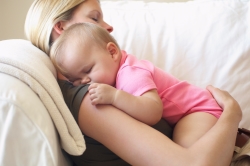This article is provided by the Baylor College of Medicine, please share your comments below…..
 Bearing fraternal non-identical twins, or dizygotic (DZ) twinning, has been known to run in families. Studies have suggested that DZ twinning is potentially influenced by more than one gene and linked to a maternal factor. In a study published in the American Journal of Human Genetics, an international collaborative team of researchers reports the finding of two genes that are associated with increased odds for women bearing fraternal twins.
Bearing fraternal non-identical twins, or dizygotic (DZ) twinning, has been known to run in families. Studies have suggested that DZ twinning is potentially influenced by more than one gene and linked to a maternal factor. In a study published in the American Journal of Human Genetics, an international collaborative team of researchers reports the finding of two genes that are associated with increased odds for women bearing fraternal twins.
“We know that dizygotic, or non-identical twins, is heritable and passed on down the maternal lineage. We had spent several years first identifying twinning genes in a really spectacular group of new world monkeys, the marmoset, who always have twins or triplets. Now we were ready to tackle the genetics of twinning in humans,” said Dr. Kjersti Aagaard associate professor of obstetrics and gynecology at Baylor College of Medicine and OB/GYN and maternal fetal medicine specialist at Texas Children’s Pavilion for Women, and one of the study’s lead authors. “Working with our colleagues around the globe, we not only found two genes with links to twinning, but to a number of different important signs of reproductive fitness.”
“There’s an enormous interest in twins and in why some women have twins while others don’t,” said Dr. Dorret Boomsma, a biological psychologist at Vrije Universiteit (VU), Amsterdam, and corresponding author for this work, who has compiled one of the largest twin databases in the world. “The question is very simple and our research shows for the first time that we can identify genetic variants [variations of a gene] that contribute to this likelihood.”
The follicle stimulating hormone (FSHB) gene, one of two genes found to be linked to DZ twinning, has shown significant effects on fertility affecting multiple reproductive aspects. For instance, FSHB helps control the menstrual cycle and the production of eggs by the ovary.
“We found that not only did the FSHB gene variant in moms associate with an increased likelihood of having DZ twins, but was associated in a gene dose-dependent manner to the amount of circulating follicle stimulating. In addition, women from four different cohorts around the globe carrying this genetic variant had their first period, menopause, their first child and their last child at an earlier age than women carrying other FSHB genetic variants,” said Aagaard.
Women who carried this FSHB genetic variant also showed signs of less occurrence of polycystic ovarian syndrome. With this discovery, researchers were able to tie this FSHB gene to multiple reproductive fitness traits.
The second gene found by the research team, SMAD3, affected the bearing of dizygotic twins a little differently.
“We found that moms who had this SMAD3 genetic variant also had a higher occurrence of twins,” said Aagaard. “But these moms were older at the birth of their last child, so it is a little bit different than what we saw with the FSHB variant.”
The SMAD3 genetic variant associated with DZ twinning, the authors propose, might increase the chances of DZ twinning by increasing the responsiveness to FSHB through the supporting granulosa cells.
Both genetic variants affect the growth of multiple follicles, which is needed for the development of non-identical twins. Dizygotic twins start with multiple ovulation, a maternal characteristic, and identical twins start with one embryo that splits in half.
This study focused on many different moms of twin cohorts from around the world, including a validation cohort of the population of Iceland. In this group, having each allelic FSHB variant increased women’s chances of having dizygotic twins by 18 percent per allele, and the SMAD3 variant increased the occurrence of twins by 9 percent per allele. Women who had both variants showed an increased chance of 29 percent.
The work has numerous potential applications in reproductive medicine and maternal health. For instance, it may help predict the outcome of multiple births and assist in the development of new strategies to optimize fertility.
Drawing on their recent work in the marmoset, Aagaard is optimistic that these and future evolution based genetic studies focused on twinning may yield key insights for pregnancy and reproductive health.
“What has always struck us about the marmoset is that their capacity for twinning is accompanied by unique adaptive traits that optimize their ability to both carry and care for multiple young at one time,” she said. “The more we can integrate our molecular and genetic findings in both marmoset and human moms, the greater the chance that we can unravel the mysteries of what enables reproductive fitness and optimal pregnancy outcomes in both singleton and multiple gestations.”
For the names, affiliations and support of the authors of this research, visit the Supplementary Materials section of the manuscript.
